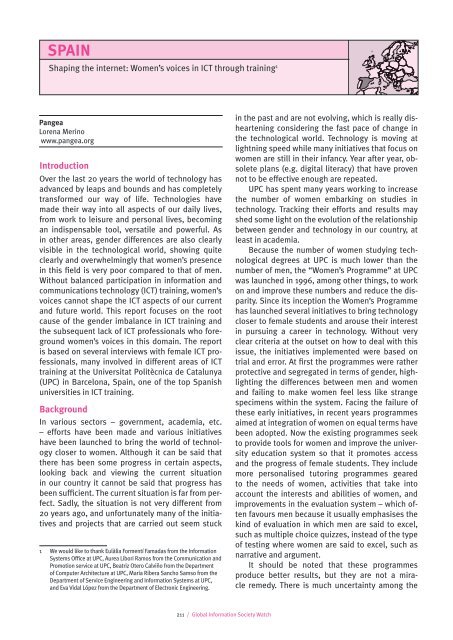gisw13_chapters
gisw13_chapters
gisw13_chapters
You also want an ePaper? Increase the reach of your titles
YUMPU automatically turns print PDFs into web optimized ePapers that Google loves.
spainShaping the internet: Women’s voices in ICT through training 1PangeaLorena Merinowww.pangea.orgIntroduction 1Over the last 20 years the world of technology hasadvanced by leaps and bounds and has completelytransformed our way of life. Technologies havemade their way into all aspects of our daily lives,from work to leisure and personal lives, becomingan indispensable tool, versatile and powerful. Asin other areas, gender differences are also clearlyvisible in the technological world, showing quiteclearly and overwhelmingly that women’s presencein this field is very poor compared to that of men.Without balanced participation in information andcommunications technology (ICT) training, women’svoices cannot shape the ICT aspects of our currentand future world. This report focuses on the rootcause of the gender imbalance in ICT training andthe subsequent lack of ICT professionals who foregroundwomen’s voices in this domain. The reportis based on several interviews with female ICT professionals,many involved in different areas of ICTtraining at the Universitat Politècnica de Catalunya(UPC) in Barcelona, Spain, one of the top Spanishuniversities in ICT training.BackgroundIn various sectors – government, academia, etc.– efforts have been made and various initiativeshave been launched to bring the world of technologycloser to women. Although it can be said thatthere has been some progress in certain aspects,looking back and viewing the current situationin our country it cannot be said that progress hasbeen sufficient. The current situation is far from perfect.Sadly, the situation is not very different from20 years ago, and unfortunately many of the initiativesand projects that are carried out seem stuck1 We would like to thank Eulàlia Formentí Famadas from the InformationSystems Office at UPC, Aurea Libori Ramos from the Communication andPromotion service at UPC, Beatriz Otero Calviño from the Departmentof Computer Architecture at UPC, Maria Ribera Sancho Samso from theDepartment of Service Engineering and Information Systems at UPC,and Eva Vidal López from the Department of Electronic Engineering.in the past and are not evolving, which is really dishearteningconsidering the fast pace of change inthe technological world. Technology is moving atlightning speed while many initiatives that focus onwomen are still in their infancy. Year after year, obsoleteplans (e.g. digital literacy) that have provennot to be effective enough are repeated.UPC has spent many years working to increasethe number of women embarking on studies intechnology. Tracking their efforts and results mayshed some light on the evolution of the relationshipbetween gender and technology in our country, atleast in academia.Because the number of women studying technologicaldegrees at UPC is much lower than thenumber of men, the “Women’s Programme” at UPCwas launched in 1996, among other things, to workon and improve these numbers and reduce the disparity.Since its inception the Women’s Programmehas launched several initiatives to bring technologycloser to female students and arouse their interestin pursuing a career in technology. Without veryclear criteria at the outset on how to deal with thisissue, the initiatives implemented were based ontrial and error. At first the programmes were ratherprotective and segregated in terms of gender, highlightingthe differences between men and womenand failing to make women feel less like strangespecimens within the system. Facing the failure ofthese early initiatives, in recent years programmesaimed at integration of women on equal terms havebeen adopted. Now the existing programmes seekto provide tools for women and improve the universityeducation system so that it promotes accessand the progress of female students. They includemore personalised tutoring programmes gearedto the needs of women, activities that take intoaccount the interests and abilities of women, andimprovements in the evaluation system – which oftenfavours men because it usually emphasises thekind of evaluation in which men are said to excel,such as multiple choice quizzes, instead of the typeof testing where women are said to excel, such asnarrative and argument.It should be noted that these programmesproduce better results, but they are not a miracleremedy. There is much uncertainty among the211 / Global Information Society Watch


